Flywheel
The engines can be fitted with different flywheels for connection to a torque converter and transmission or a fixed or flexible coupling. Refer to Sales Support Tool, Partner Network. The flywheel stores energy created during the power stroke and releases it during the rest of the cycle, which reduces speed variations in the crankshaft and timing during the cycle. It is especially important that the flywheel has sufficient inertia to provide good starting characteristics at low temperatures.
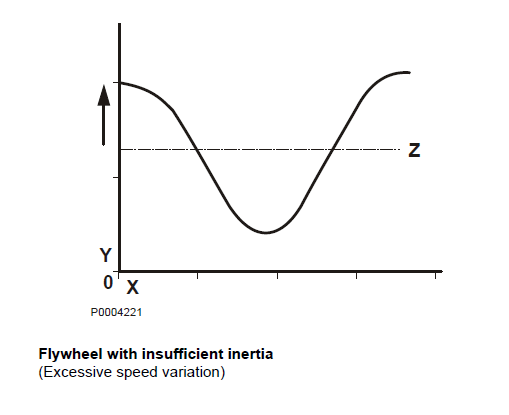
Inertia
A given minimum rotation inertia is necessary to maintain a sufficiently high piston speed during the compression stroke in order to provide enough compression heat for the injected fuel to ignite. Even if the average initial cranking speed is the same on flywheels with different inertias, the cyclical speed variation can vary significantly (see illustration). Low inertia flywheels are preferable in vehicular applications where relatively high engine speeds prevail and where fast acceleration and deceleration is required. Higher inertia flywheels are required for many industrial applications with constant revolutions or medium loads in order to reduce engine or driven equipment cyclical unevenness. They also reduce temporary engine speed changes due to loads suddenly being removed or applied. Flywheels with the highest possible inertia must be used on electrical generators and other engines with relatively low or constant rpm that require fine adjustment, where cyclical unevenness must be kept to a minimum. They are also suitable for applications with large loads where as much assistance as possible is required from the flywheel so that the engine does not stop when sudden loads are applied.
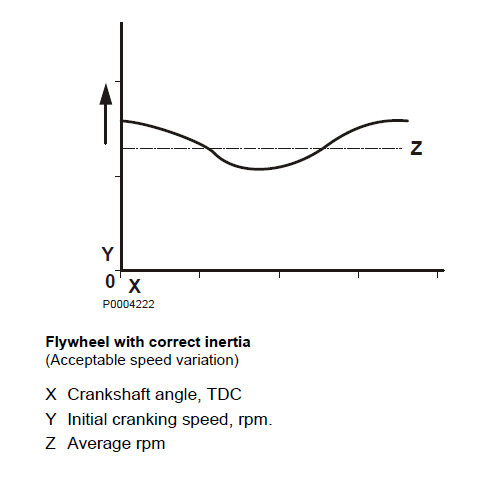
Flywheel ring gear
On certain applications where engine rpm is sensed via the flywheel ring gear by magnetic sensors, it is necessary to know the number of teeth. Please contact Volvo Penta, Sales Engineer Industrial
Flywheel Housing
General SAE measurement recommendations must be followed when manufacturing flywheel housings and flange couplings (for driven units). The table below details the most important measurements for the SAE number concerned.

SAE number | A Diameter | B | C | D | Bolts (12 positions) Measurement |
SAE 1 | 511.18 mm (20.125") | 530.23 mm (20.875") | 552.45 mm (21.750") | 131.5 mm (5.18") 100 mm (3.94") 114 mm (4.49") 114 mm (4.49") | M10 M10 7/16" - 14 UNC |
SAE 2 | 447.68 mm (17.625") | 466.73 mm (18.375") | 488.95 mm (19.250") | 110.5 mm (4.35") 131.5 mm (5.18") | M10 M10 |
SAE 3 | 409.58 mm (16.125") | 428.60 mm (16.874") | 480 mm (18.898") | 110.5 mm (4.35") | M10 |
Spacer Ring (Flywheel Housing/Flange Connection)
If the flywheel housing and the driven unit have different SAE numbers, they may be coupled using special spacer rings.
The following spacer rings are available as accessory equipment.
1 Spacer ring SAE No. 1-1
2 Spacer ring SAE No. 1-2
3 Spacer ring SAE No. 1-3
4 Spacer ring SAE No. 2-3
The spacer ring acts as an intermediary connection between the flywheel housing coupling flange and the torque converter coupling flange. A spacer ring can also be used as an adapter from the flywheel housing to a smaller flange.
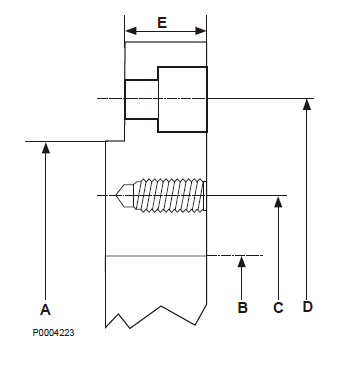
Measurement
A Flywheel housing guide
B Inner diameter, spacer ring
C Partition diameter, hole for torque converter housing
D Partition diameter, hole for flywheel housing
E Spacer ring extension
Spacer ring | Measurement | ||||
A | B | C | D | E | |
SAE 1-0 | 511.18 mm (20.125") | 647.70 mm (25.500") | 530.22 mm (20.875") | ||
SAE 1-1 | 511.18 mm (20.125") | 511.18 mm (20.125") | 530.22 mm (20.875") | ||
SAE 1-2 | 511.18 mm (20.125") | 447.68 mm (17.625") | 466.73 mm (18.375") | ||
SAE 1-3 | 511.18 mm (20.125") | 409.59 mm (16.126") | 428.60 mm (16.874") | ||
SAE 2-3 | 447.68 mm (17.625") | 409.59 mm (16.126") | 428.60 mm (16.874") | ||
Power Transmission
Volvo Penta engines can be equipped with different power take-off couplings depending on the application the engine is used for.
WARNING!
When engines are delivered without protection all rotating parts must be protected if it, after being built into the respective application, is necessary for personal safety.
Disconnectable Power Take-off
Disengageable power take-offs are required in cases where load exists at start and where the load is required to be disengaged while the engine is running. The over center eccentric effect means that engagement proceeds smoothly and progressively, and that the power take-off is locked securely in drive mode.
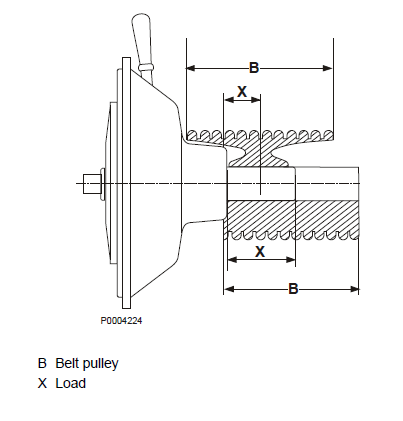
NOTICE! In order not to overload the power take-off bearings, the side load (L) may not exceed given values. Refer to the table two pages ahead in this manual. The side load can be reduced by using a larger belt pulley (B). In this case the driven belt pulley diameter must naturally also be changed in order to maintain a constant relationship.
Always try to install the belt pulley hub as close to the power take-off housing as possible. The belt pulley may under no circumstances be installed with its center further from the shaft than half the length of the free shaft. The belt pulley must be bell shaped as illustrated. This type of belt pulley may be located so that part of the disc covers the bearing housing thus reducing the x-value, which in turn allows the side load to be increased.
Calculation of side load
The following formula may be used to calculate power take-off side load:
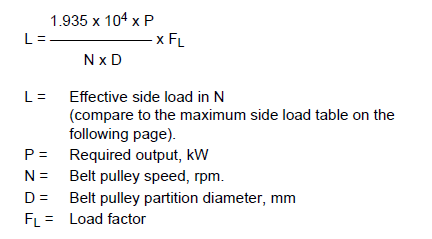
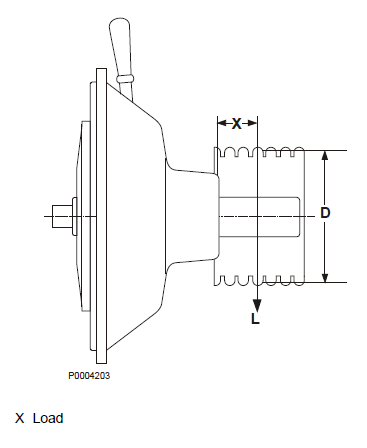
Target value for FL (load factor)
The coupling manufacturer has provided a somewhat modified formula and maximum permissible side load table. This simplifies calculation as it does not include any machinery factor.
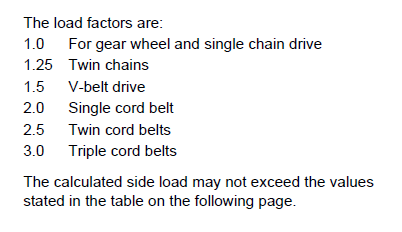
Flexible Coupling
Flexible couplings are used for direct coupling to generators etc. Torsional oscillations must be calculated when couplings with different inertias are used in order to ensure the couplings are suitable. Contact Volvo Penta for further information.
The couplings can handle normal, transient torque. Where extreme torque may occur, steel couplings or couplings with overload protection must be used.
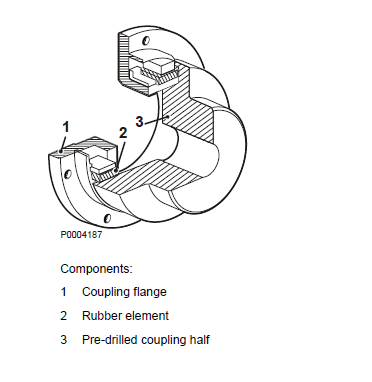
NOTICE! The couplings are factory pre-drilled, but the customer must drill additionally to ensure a precise fit. Refer also to the Engine Characteristics page 12 chapter, and Torsional Vibrations page 117 section in the “Power take-off connections” chapter.
Torque Convertors
A torque converter is a device that transfers power and motion from an engine to a transmission with the aid of hydraulic fluid. There are two types of system that transfer energy hydraulically. They are called hydrostatic and hydrodynamic systems. Hydrostatic systems function according to the principal that an enclosed fluid transfers a given pressure. Hydrodynamic systems function according to the principal that a fluid in motion has a given pressure. A torque converter comprises four parts: the impeller, which is the driving part, the turbine, which is the driven part, the stator, which is spline attached to a fixed hub, and the converter housing, which couples the converter to the engine. The impeller and the converter housing form the outer casing.
The turbine runs inside the outer casing and is connected to the output shaft.
Oil is the only connection between the turbine and the impeller.
The stator is spline attached to the stator hub, which is fixed and does not rotate in either direction. A gear wheel is spline attached to the impeller hub and drives the hydraulic pumps located in the converter housing via a gear wheel.
Just like all man-made machinery, a torque converter is not 100% efficient. Because the parts are not mechanically connected, a degree of oil slippage occurs, which produces heat. By using a pump and an oil cooler the excess heat created by lost motion and friction is led away from the converter. The pump is used to provide the converter with cool, filtered oil and force hot oil away from the converter through the oil cooler.
IMPORTANT!
Certain factors must be taken into consideration when connecting the torque converter oil cooler to the engine cooling system. Refer to the Cooling System chapter.
A torque converter has several advantages:
- It absorbs shocks, which extends drive train life.
- It multiplies torque and delivers power smoothly, which provides more motive power to the wheels.
- It can be used in conjunction with a powershift transmission, which allows rapid gear shifts even under load.
- It requires no regular adjustment and has no complicated parts.
For More Volvo Engine workshop information, please visit
Rear Engine Mounting of Volvo Engine
Copyright © Guangxi Dingbo Generator Set Manufacturing Co., Ltd. All Rights Reserved | Sitemap
Update cookies preferences